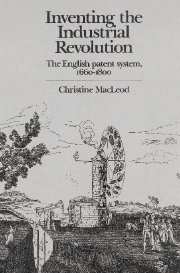Book contents
- Frontmatter
- Contents
- List of tables and figure
- Acknowledgements
- List of abbreviations
- Notes on style
- Introduction
- 1 Patents 1550–1660: law, policy and controversy
- 2 The later-Stuart patent grant – an instrument of policy?
- 3 The development of the patent system, 1660–1800
- 4 The judiciary and the enforcement of patent rights
- 5 The decision to patent
- 6 Invention outside the patent system
- 7 Patents in a capitalist economy
- 8 The long-term rise in patents
- 9 The goals of invention
- 10 Patents: criticisms and alternatives
- 11 A new concept of invention
- Notes
- Bibliography
- Index
- Frontmatter
- Contents
- List of tables and figure
- Acknowledgements
- List of abbreviations
- Notes on style
- Introduction
- 1 Patents 1550–1660: law, policy and controversy
- 2 The later-Stuart patent grant – an instrument of policy?
- 3 The development of the patent system, 1660–1800
- 4 The judiciary and the enforcement of patent rights
- 5 The decision to patent
- 6 Invention outside the patent system
- 7 Patents in a capitalist economy
- 8 The long-term rise in patents
- 9 The goals of invention
- 10 Patents: criticisms and alternatives
- 11 A new concept of invention
- Notes
- Bibliography
- Index
Summary
The English patent system is both older and younger than we tend to think. Patents for invention have been granted regularly since the middle of the sixteenth century, but it was not until 1852 that the first major legislation on patents was enacted by parliament and the Patent Office established. Between 1660 and 1800 the ‘patent system’ was something of a misnomer. It was not the orderly protector and promoter of inventions that one steeped in the patent law of the twentieth, or late nineteenth, century might imagine. Yet neither was it the corrupt dispenser of Court patronage that one whose perspective was the early-Stuart monopolies controversy would perhaps expect. This study starts by explaining how a recognizable patent system emerged from the monopoly muddle. The Statute of Monopolies (1624), enacted in an attempt to curtail the crown's abuse of patents, exempted from its general proscription those granted for new inventions. Contrary to the impression often given, this essentially negative piece of legislation was insufficient by itself to produce an institution at all capable of meeting the needs of the inventors of the industrial revolution. Development was gradual and quiet: there was no legislation, little activity in the law courts, and only muffled sounds to be heard from a few books and pamphlets. For a long time, the system's survival was precarious: invention took place outside it and often in ignorance of it.
- Type
- Chapter
- Information
- Inventing the Industrial RevolutionThe English Patent System, 1660–1800, pp. 1 - 9Publisher: Cambridge University PressPrint publication year: 1988
- 6
- Cited by

